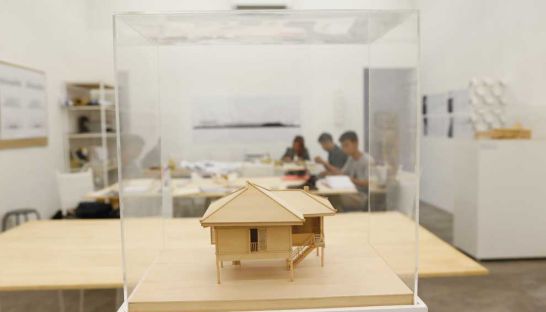Recapturing Vann Molyvann one model at a time
Recapturing Vann Molyvann one model at a time
After five years of collecting dust in storage, little models of famous Cambodian architecture under glass boxes stand scattered across Sa Sa Bassac’s studio, while students work on recreating even bigger models of iconic buildings on nearby desks.

The Vann Molyvann Project 2015 has begun its latest project, including both American and Cambodian students, fellows and architects who will occupy Sa Sa Bassac over the summer as their workshop and gallery to recreate Vann Molyvann’s Olympic Stadium. Their work will also build models of three other buildings from Phnom Penh and Sihanoukville that the famed architect designed.
The students participating in the project come from four different schools: Phnom Penh’s Royal University of Fine Arts and Norton University, New York’s Parsons The New School for Design and Melbourne’s University of Melbourne.
The project aims to document Vann Molyvann’s remaining buildings in an effort to generate a database of measured drawings, as well as increase the possibility of his work’s preservation through exhibitions and publications. It also serves to connect young American architects and Cambodian architects together and provide educational materials that focus on the Kingdom’s historical monuments.
Tum Uryphol, a fifth-year student from the Royal University of Fine Arts, was introduced to Vann Molyvann and his work when she was 16-years-old by her parents. His worked inspired her to pursue a degree in architecture.
“I studied a lot of Vann Molyvann’s work [in university], and I am proud of his work because it made people [learn] more about Cambodia internationally,” she said. “I wanted to join this project so I could learn even more about his work.”
She said there is a benefit from working with American students, as well as other Cambodian students.
“I like to work with American or foreign students because they work differently, [and] it can enhance my knowledge. It creates an open-mind and introduces me to other techniques,” she said.
While the two American students from Parsons will join the project in July, Mikaela Kvan, a former Parsons student and current holder of the fellowship is already representing the USA. Kvan’s key role is conducting research on the way urbanization affects society. For Phnom Penh, Molyvann’s projects have made a huge and enduring impact on society.
As the students measure and study the structural aspects of Vann Molyvann’s work, Kvan will study the impact the structures have made on the locals surrounding the area through interviews.
“I’m hoping to gain a dynamic insight into a culture, one that is very foreign to me, with very different ways of living and understanding… [I will see how] people use the structure, what elements they like best, what their overall impressions are of beauty and the aesthetic side of things,” she said.
As an urban researcher, Kvan is interested in how architects build a structure. For this project, the details of Vann Molyvann’s work, is what she was most interested in.
“I was excited by the idea of coming to work on a project that focused on the new Khmer architecture and Vann Molyvann’s architecture. He didn’t just create the structures, but he really contributed to the whole culture of a country,” she said. “He’s an international icon.”
The team is led by an alumni from the Royal University of Fine Arts, Pen Sereypagna, who is now a freelance architect and urban researcher. After picking the candidates for the project, his role is to oversee all aspects of the project.
“I’m very honored and very proud to be part of something that is for the whole of Cambodian society.”













